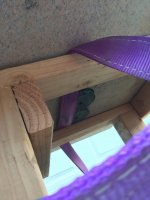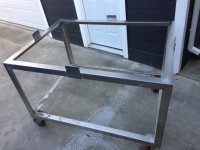I recently purchased a 36x48" surface plate with a stainless steel stand on casters from a tool liquidator. The surface plate was a little pitted but not too much from what I can feel. I'm planning on getting it calibrated again, but while transporting it I realized there was a problem with how the stone was being supported. The stand doesn't have cross members to support the stones three contact pads. Well, there are 4 contact pads, two of them are button up against one another to act as one contact point.
So I need to add those cross members, I think I'm supposed to weld nuts into place and use those to level the stone. But seeing the stone is on casters I don't think leveling is an issue. Also thinking about putting a support brace in the middle of the 4' span, so the weight is more evenly distributed. The stone does weigh 1200 lbs but whatever is on top of it.
I'm assuming its made from 304 stainless so I'm wondering if I should be using stainless for the cross member or can I get away using hot rolled steel? Stainless is pretty expensive once I started pricing out what I would need. 2" angle, 0.375" tick.
Adding photos:
View attachment 200432View attachment 200433View attachment 200434View attachment 200435View attachment 200436
It's actually two inch, quarter inch walled angle iron.
So I need to add those cross members, I think I'm supposed to weld nuts into place and use those to level the stone. But seeing the stone is on casters I don't think leveling is an issue. Also thinking about putting a support brace in the middle of the 4' span, so the weight is more evenly distributed. The stone does weigh 1200 lbs but whatever is on top of it.
I'm assuming its made from 304 stainless so I'm wondering if I should be using stainless for the cross member or can I get away using hot rolled steel? Stainless is pretty expensive once I started pricing out what I would need. 2" angle, 0.375" tick.
Adding photos:
View attachment 200432View attachment 200433View attachment 200434View attachment 200435View attachment 200436
It's actually two inch, quarter inch walled angle iron.
Last edited:








